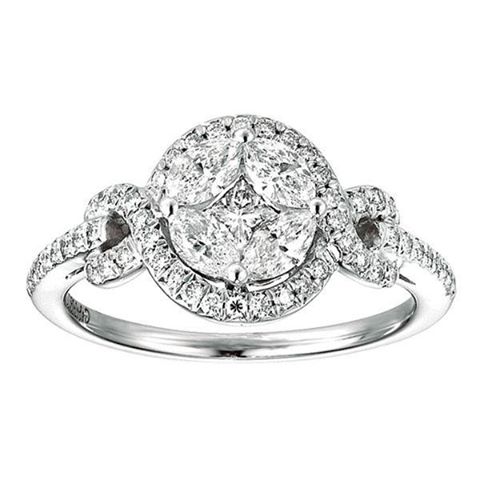How to Choose an Engagement Ring
-
Engagement and wedding rings come in a huge array of styles and material. When shopping for engagement and wedding rings, many couples go together — or at least pre-shop together so that each person has an idea of the other's taste. When choosing rings, consider your lifestyle and price range, and try on many different rings before buying anything.
\r\n
\r\n\r\n
The classic engagement ring is composed of two parts: a diamond and a setting. For the best value, find the engagement ring setting she'll love then devote the remainder of your budget to a beautiful, certified diamond.
\r\nThis guide will help you choose an engagement ring setting she'll love, and decide on the right combination of diamond size and quality, so you're sure to choose the perfect ring.
\r\nSelecting a diamond
\r\nA diamond is the hardest transparent substance known to man, one hundred times harder than ruby or sapphire. This durability, along with its light, has made diamonds an enduring symbol of marriage. They are evaluated and classified by the four C’s—cut, color, clarity and carat weight.
\r\nCut
\r\nA diamond’s cut and proportion determine its brilliance and fire, making the cut perhaps the most important factor in a diamond’s beauty. Each facet acts as a light-dispersing mirror, so more facets generally mean greater beauty. A modern, round-brilliant-cut diamond has 58 facets, which makes it more brilliant than other shapes.
\r\nColor
\r\nThe Gemological Institute of America (GIA) grades color starting with the letter D (colorless) through the letter Z (progressively more yellow). In nature, diamonds occur in virtually every color and shade: blue, pink, lavender, yellow, green, red and even black. Colored diamonds are increasingly popular for engagement rings, and some rare colors are quite pricey.
\r\nClarity
\r\nInternal imperfections, such as small cracks, whitish dots or dark spots, are called inclusions. External flaws are blemishes. Generally speaking, the fewer the inclusions and blemishes, the clearer and more brilliant the diamond, the rarer it is, and the more it’s worth.
\r\nThe GIA classifies diamonds and their flaws into the following categories:
\r\n- \r\n
- \r\n
FL: Flawless, meaning without any surface characteristics or internal imperfections. Extremely rare.
\r\n \r\n - \r\n
IF: Internally flawless with only minor external blemishes that a jeweler can polish away.
\r\n \r\n - \r\n
VVS1 and VVS2: Very, very small inclusions that are difficult for a qualified observer to detect.
\r\n \r\n - \r\n
VS1 and VS2: Very small inclusions visible only under magnification.
\r\n \r\n - \r\n
SI1 and SI2: Small inclusions that are readily apparent under magnification but not to the naked eye.
\r\n \r\n - \r\n
I1, I2 and I3: Imperfect grades in which the flaws may or may not be visible to the naked eye. Much lower in price and generally don’t appreciate in value.
\r\n \r\n
Carat weight
\r\nGemologists measure the size of diamonds in terms of weight, specifically in carats. A carat contains 100 points. If a jeweler says a stone weights 25 points, it’s 1/4 carat. While size still matters, it is almost meaningless outside the context of cut, clarity and color. A large stone that is dull, flawed, or improperly cut is worth less money than a perfect little diamond.
\r\nSelecting a setting and metal
\r\nChoosing the right setting for a diamond is like choosing the right frame for a picture. Classic settings include the prong-less bezel, elaborate carved scroll, clean-looking channel, decorative cluster, flush-lying gypsy, expensive invisible, glittery pavé, traditional prong, light-reflecting silver cups, singular solitaire, floating tension, and six-pronged Tiffany.
\r\nThe metal of your ring should flatter your skin tone and the color of your stone. Platinum is the most expensive, but beautiful, and both hard and resilient. Whatever metal you choose, you may have the ring designed with a variety of finishes, patterns or edgings.
\r\n
\r\nTips:
\r\n- \r\n
- If purchasing a ring off the internet, only buy round settings. You won't be able to see flaws in other designs. \r\n
- Ring designs to consider include engraving, filigree, pave, micropave and milligrain. \r\n
- If you buy a ring without your girlfriend having any input into the decision, she may be unhappy with the shape, color, or other elements of it. Give this deep consideration as it's the ring she'll be wearing for the rest of your lives together. On the other hand, some girlfriends would be disappointed if you proposed without the ring already in place. Ask the jeweler if it's possible to make an exchange if she really doesn't like your choice. \r\n
- You may prefer to have a different gem stone at the center of your ring. A three stone ring with diamonds on either side of a colored gem stone can make an impressive engagement ring. Rubies and sapphires are hard wearing but emeralds are more delicate. These stones are also a lot less expensive than the traditional choice of diamond. Again, clarity is important in these stones too and the color should be bright and intense. \r\n
- If your potential fiancee has a close sister or friend, take the sister/friend along for advice. \r\n
- If she's close to her mom, her mom is likely to know what she'll like. \r\n
- A Claddagh ring is a traditional Irish engagement ring and can have diamonds added. If her Irish background is important to her, this is a romantic and beautiful choice. \r\n
Related Articles
- \r\n
